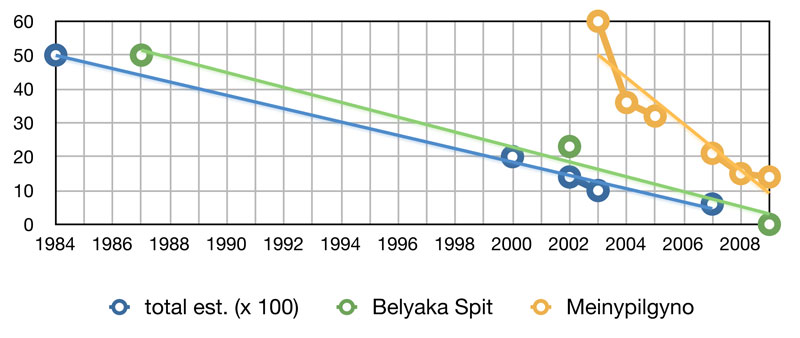Spoon-billed Sandpiper populations have been declining for decades, but the reasons are still unclear.
Update September 2010 – My conclusion below is that climate change is likely to be the cause of declines, but recently Zockler et al (pdf here) concluded that hunting on the wintering grounds is a more significant threat. Apparently fledging rates at the study sites in Siberia have been good for the last several decades, but fewer adults return each year. So something is happening to them in migration and/or winter.
Thanks to the dedicated efforts of a few researchers there is quite a lot of information available, the best source and the source of most of the info here is the 2008 draft Action Plan.
A detailed summary is at Birdlife International and more in their Red Data Book. Lots of technical info and links to reports are available online at Christof Zöckler’s Spoon-billed Project site at ArcCona.

Spoon-billed Sandpiper nests in a very specialized habitat – low sandy or gravelly dune ridges covered with crowberry less than 5 cm high, usually at the mouths of estuaries and always within a few kilometers of the coast. On migration and in winter they are found on tidal flats, often with relatively sandy substrate. For example, the only known (newly discovered) wintering site in China (about 10 Spoon-billeds in 2009-2010) is also the only place in China where Sanderling winters regularly (Paul Holt, pers. comm.).
Reasons for the decline are uncertain. The 2005 and subsequent Action Plans list and discuss many known and suspected threats, but relies almost entirely on anecdotal reports and the impressions of the few researchers who work on the species.
Primary threats on the breeding grounds:
Habitat degradation and fragmentation – many new salmon fishing camps have been established in southern parts of the sandpiper’s breeding range in recent years, and it’s unlikely that sandpipers can nest successfully in close proximity to this level of human activity. However, other parts of the breeding range are apparently still relatively undisturbed and sanpiper numbers have declined there.
Collecting of skins and clutches – Shockingly, the 2005 Action Plan mentions several known or suspected cases of collectors paying for specimens of Spoon-billed Sandpipers and their eggs. It’s not clear whether this is is a major contributor to the species’ decline, but the selfishness of these collectors is unbelievable.
Hunting and trapping – once thought to be insignificant, but in summer 2009 researchers surveying potential nesting habitat in Kamchatka found evidence of substantial shorebird hunting.
Climate Change – Possibly the leading cause of decline, as longer and drier growing seasons allow different species of plants to flourish and species such as crowberry and willows to grow taller. The report of 2009 survey results includes the observation that in Kamchatka many former breeding sites no longer appear suitable due to changes in vegetation, presumably climate-related.
Primary threats on the staging and wintering areas:
Large Scale Reclamation – especially the massive project at Saemangeum in South Korea, which was known to be a migratory stopover site for substantial numbers, perhaps hundreds, of Spoon-billed Sandpipers. Many other, smaller reclamation projects also must have an impact, although the declines began long before the completion of the Saemangeum seawall in 2006.
Urban / Industrial Development – Rapid development continues along much of the Asian coast leading to an incremental loss and degradation of tidal habitat
Hunting and Trapping – subsistence farmers in southeast Asia (particularly Myanmar and Bangladesh) catch sandpipers for food, and at least occasionally catch Spoon-billed Sandpipers there.
Pollution – The increasing industrialization of southeast Asia, and increased use of agricultural fertilizers and pesticides, is seen as a significant and growing threat to the health of coastal wetlands there.
An overall picture emerges of a very specialized bird, nesting and wintering in a narrow strip along the immediate coast, threatened by a variety of changes in its landscape. The conservation challenges seem enormous, not the least of which is education and awareness, as the species seems to be on the verge of extinction while most of the people who live within its range, and many of the world’s birders, remain unaware of its plight.


Thanks for a well researched answer. Climate change, natural or human caused, is a possible factor but thanks for identifying causes. These present a real opportunity for solution.